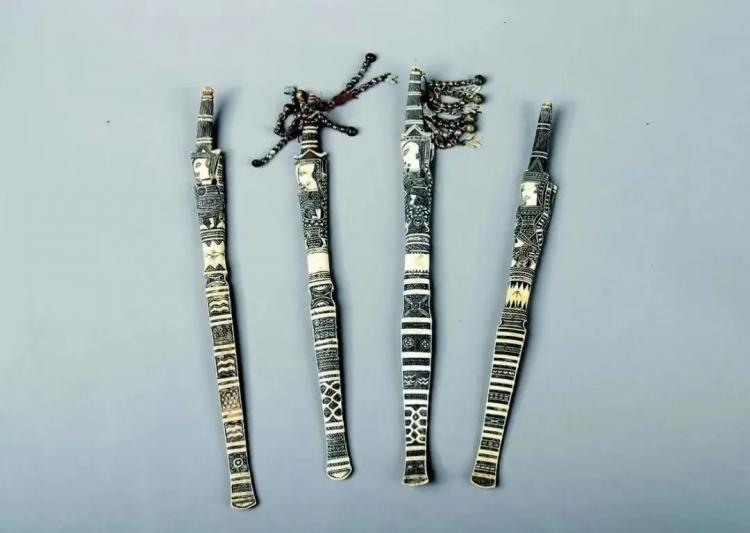


————————————————
Li ethnic group bone hairpin
我想用自己的双手去创作,
这样我就能赋予它们我自己的个性,
我会把它们变成交流的物体,
激发人们的感觉和想象力。
简介
Brief introduction

黎族骨簪是一种具有深厚文化背景的头饰,
主要用兽骨或牛骨等材质雕刻而成。
它们通常长26厘米,宽1.6厘米,制作工艺复杂,
包括洗刷去油脂、截料、修整成型、磨制、
钻孔雕刻和装饰着色等步骤。
黎族骨簪不仅是头饰,还具有象征意义,
常用于装饰并象征着吉祥和祝福
Li ethnic bone hairpin is a headpiece with a profound cultural background,
It is mainly carved from materials such as animal bones or cow bones.
They are usually 26 centimetres long and 1.6 centimetres wide, with complex manufacturing processes,
Including washing to remove grease, cutting materials, shaping, grinding
Steps such as drilling, carving, and decorative colouring.
The Li ethnic bone hairpin is not only headwear but also has symbolic significance,
Commonly used for decoration and symbolising auspiciousness and blessings.
历史
history

历史记载:
黎族是海南岛上最早的世居民族,
汉代《汉书·地理志》已有关于黎族使用骨器的记载,但直至清初,
黎族骨簪才有明确的文献记载。
清人屈大钧《广东新语》记载黎族男子有椎髻插梳的习俗,
并描述了骨簪的佩戴方式。
Historical records:
The Li ethnic group is the earliest living ethnic group on Hainan Island,
The Han Dynasty's "Geographical Records" already recorded the use of bone tools by the Li ethnic group, but it was not until the early Qing Dynasty that,
The Li ethnic group's bone hairpin has a clear historical record.
Qu Dajun, a Qing Dynasty scholar, recorded in his "Guangdong New Language" that Li ethnic men had the custom of threading a hairpin into their hair,
And described the wearing method of the bone hairpin.

起源传说:
黎族骨簪的制作技艺历史悠久,
其起源与黎族的原始文化和宗教信仰密切相关。
据传,人形骨簪上的头戴官帽的人头像
为古代的雷神(又称雷王),
或是部落首领“总管三”,
他英勇善战,为百姓排忧解难,
是古时黎族民间崇拜的英雄。
Origin legend:
The production technique of Li ethnic hairpin has a long history,
Its origin is closely related to the primitive culture and religious beliefs of the Li ethnic group.
It is said that the portrait of a person wearing an official hat on a humanoid bone hairpin
For the ancient thunder god (also known as Thunder King),
Or the tribal leader 'General Manager Three',
He is brave and skilled in battle, providing relief and assistance to the people,
He was a hero-worshipped by the Li people in ancient times.
欣赏
appreciate



黎族骨簪不仅具有装饰作用,
还承载着丰富的文化内涵。
骨簪上的图案和形象通常反映了黎族
的传说和历史,例如人形骨簪上的人物形象
可能是黎族传说中的部落首领,
象征着英雄和勇敢。
这些骨簪的制作需要耗费大量时间和精力,
通常需要5到12天的时间来完成,
雕刻技艺要求高,
需要雕刻者具备艺术造诣和耐心。
。
The Li ethnic group's bone hairpin not only serves a decorative purpose,
It also carries rich cultural connotations.
The patterns and images on the bone hairpin usually reflect the Li ethnic group.
The legends and history, such as the character images on the human-shaped bone hairpin
Perhaps the tribal leader in the legend of the Li ethnic group,
Symbolising heroes and bravery.
The production of these bone hairpins requires a lot of time and effort,
It usually takes 5 to 12 days to complete,
The carving skills require high standards,
Sculptors need to possess artistic expertise and patience.
————————————————



————————————————
制作工艺
Production process



选材:
黎族骨簪多选用牛骨或兽骨作为原料,
这些骨头需经过精心挑选,
确保质地坚硬且适合雕刻。
制作流程:
洗刷去脂:
将骨头放在水中浸泡或煮透,
去掉骨头中残余的易腐物。
Material selection:
The Li ethnic group often uses cow or animal bones as raw materials for their bone hairpins,
These bones need to be carefully selected,
Ensure that it is solid and suitable for carving.
Production process:
Wash and remove fat:
Soak or boil the bones thoroughly in water,
Remove the remaining perishable substances from the bones.


截料:
根据所需规格、尺寸,
将骨料砍成三至四根长条状骨坯。
现代制作中,
截料步骤大部分采用机器切割。
整型:
把骨簪坯料制成模型,
单人型或双人型。
磨制:
对骨器进行打磨加工,
使其通体磨光。
Cut off material:
According to the required specifications and dimensions,
Cut the aggregate into three to four long strip-shaped bone blanks.
In modern production,
The cutting steps mostly use machine cutting.
Integer:
Make a model of the bone hairpin blank,
Single or double person.
Grinding:
Polish and process bone tools,
Make it completely polished.


钻孔雕刻:
在磨光的骨坯上钻孔并雕刻传统花纹图案。
装饰或着色:
使用植物染色剂或木炭灰等涂抹在刻好的纹饰上,再用蜂蜡进行固色和抛光。
制作周期:
一支制作好的骨簪大约需要5到12天,
具体取决于手艺人的熟练程度。
Drilling carving:
Drill holes and carve traditional patterns on the polished bone blank.
Decoration or colouring:
Apply plant dyes or charcoal ash onto the carved patterns, then fix and polish with beeswax.
Production cycle:
A pre-made bone hairpin takes about 5 to 12 days,
It depends on the skill level of the craftsman.
造型与纹饰
Styling and ornamentationSelf narration


造型:
黎族骨簪造型别致,一般为侧身人头像,
分为单人骨簪与双人骨簪。骨簪整体扁平,
长度多在15至26厘米之间,
宽度在1.2至2.5厘米之间。
纹饰:
骨簪上的纹饰精美繁复,具有极高的艺术价值。纹饰主要包括人纹、动物纹、
植物纹和几何纹等,其中人纹是主体,动物纹、植物纹和几何纹等作为辅助陪衬。
这些纹饰不仅体现了黎族的审美观念,
还蕴含了丰富的文化内涵和象征意义。
Styling:
The Li ethnic group's bone hairpin has a unique design, usually featuring a profile picture of a person,
Divided into single-person bone hairpins and double-person bone hairpins. The bone hairpin is generally flat,
The length is mostly between 15 and 26 centimetres,
The width is between 1.2 and 2.5 centimetres.
Ornamentation:
The decorations on the bone hairpin are exquisite and complex, with extremely high artistic value. The decorative patterns mainly include human patterns and animal patterns.
Plant patterns and geometric patterns, among which human patterns are the main body, and animal patterns, plant patterns, and geometric patterns are used as auxiliary embellishments.
These patterns not only reflect the aesthetic concepts of the Li ethnic group,
It also contains rich cultural connotations and symbolic meanings.
意义
significance


黎族骨簪是黎族优秀传统文化的代表之一,
它承载了黎族人民对于生命起源、
祖先认同和迁徙之路的记忆与想象。
同时,
它也是黎族民间艺术高度发展的代表作之一。
骨雕艺术,从远古时期走来,
斗转星移间传承十余万年,
如今面临着“后继无人”的危机。如今,
黎族骨器技艺没有省级非遗传承人,
白沙县级非遗传承人仅有符明庄、陈玉跟、
符元清这三人,
民间掌握黎族骨器制作技艺的老艺人也屈指可数。
The Li ethnic group's bone hairpin is one of the representatives of the excellent traditional culture of the Li ethnic group,
It carries the Li people's understanding of the origin of life
Memories and imaginations of ancestral identity and migration paths.
Meanwhile,
It is also one of the representative works of the highly developed Li ethnic folk art.
Bone carving art has been around since ancient times,
Over 100000 years have passed between the changing stars and the changing stars,
Now facing the crisis of 'no successor'. Nowadays,
There is no provincial-level inheritor of the Li ethnic group's bone and artefact skills,
The only inheritors of intangible cultural heritage at the county level in Baisha are Fu Mingzhuang and Chen Yutao
Fu Yuanqing, these three people,
There are only a few old artists among the people who have mastered the craft of making Li ethnic bone artefacts.
